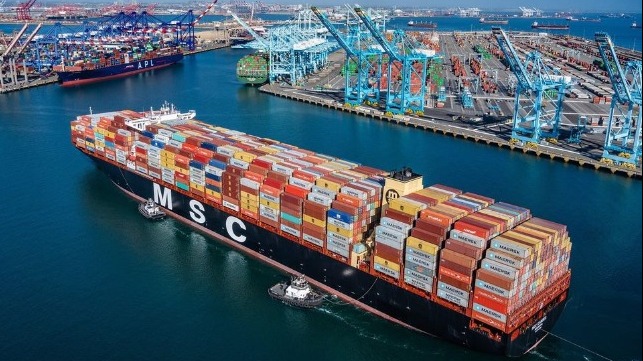Los Angeles Addresses Backlog and Diverts Ships as Volumes Rise

A pandemic-driven buying surge as American consumers continue to buy goods instead of spending on services is fueling the strong import volume increases at the Port of Los Angeles and other U.S. ports. Providing its monthly update, the Port of Los Angeles said that with 62 ships currently at anchor and no signs of a let-up in the year-over-year volume increases that the port needs to work with all its constituents and do things differently.
“All indications point toward a strong flow of imports over the next few months as consumers continue an unprecedented buying surge which began last summer,” said Port of Los Angeles Director Gene Seroka. Acknowledging the delays and the need to keep goods flowing to fuel the U.S. economy, he said that the top priority remains to chip away at the backlog. The port currently has enough volume in the anchorage for a month’s worth of work and with more vessels arriving they need to “meter the cargo,” or the port could continue to have ships at anchor well into the summer of 2021.
While the Port of Los Angeles does not want to turn away volume, they admitted that working with the liner companies, ships are being diverted. Hapag-Lloyd is among the carriers that have adjusted schedules using alternate ports and CMA CGM moved its express service to the Port of Oakland. Los Angeles however recognizes that its backlog is also affecting other ports’ operations and carriers’ need to get back on to regular schedules.
In November 2020, the wait time at anchorage was 2.5 days and it has risen to an average of 8 days with 85 percent of ships now going into the anchorage waiting for terminal space. This is despite the port handling 15 ships at a time up from its normal 10 to 12 ships docked at one time. A total of 87 cargo vessels arrived in January, including eight extra loaders while there were no canceled sailings.
January was the sixth consecutive month of year-over-year volume increases and while it was up just 3.6 percent in Los Angeles it was up more than 11 percent for the combined San Pedro Bay port complex. The volume also remains one-sided with imports far outweighing exports, which Seroka called dismal and attributed for some of the operating issues at the port.
Asked where the bottleneck was in the supply chain, Seroka said it started with the volumes coming into the ports during a pandemic as well as labor shortages and equipment issues. Retailers are having a hard time absorbing the imports at the rate they are arriving and truckers and rail connections are challenged to manage the volumes, especially because of the lack of exports which makes it difficult to create an economic balance between outbound and return traffic.
The increases in volumes have meant that vessels are spending more time at the dock and terminal utilization has risen above 90 percent signaling that they are running at full capacity. They are also lacking space for the containers. Labor at the port has also been impacted with currently 800 of the 15,000 longshoremen off the job due to illness or quarantines related to COVID-19.
Among the efforts designed to help alleviate the backlog are new data tools to aid in planning and increasing efficiencies as well as incentives that the terminals can earn for shortening turn times and more trucks unloading and loading during a single stop at the terminals. The port acknowledges that the terminals are working at or near capacity and have been slowed by COVID-19 precautions for their employees.
In addition to hiring additional labor, the port is also placing a high priority on vaccinating the 15,000 longshoremen and 80,000 to 85,000 people working with the truckers, rail lines, and terminals at the port. They offered the cruise terminal to serve as a mass inoculation location when the vaccine is available. Last week, Long Beach’s health department made the first 800 doses available for the ports and the union reported the appointments were booked in less than 20 minutes.
“We are grateful to our dock workers, truckers, and terminal operators who have worked every day since the pandemic began to process these record volumes. We will continue to advocate at all levels of government for sufficient supplies to ensure every waterfront worker has a chance to be vaccinated,” said Seroka.
Additionally, he cited that lag in U.S. exports saying that they have been down 25 of the last 27 months at the Port of Los Angeles. He cited declines in agricultural export as well as automotive and manufacturing. Seroka said, “What we’re experiencing is one-way trade, which has created challenges for the entire supply chain.”
He repeated his calls for action to address American trade policy which along with China’s retaliatory actions in the trade war and the value of the U.S. dollar are the issues creating the trade imbalance at the Port of Los Angeles. The volume of empty containers going out of the port is double the loaded exports, which is also putting strains on the operations.
The Port of Los Angeles is projecting a 34 percent year-over-year increase in volume for February to 730,000 TEU, and an increase in month-over-month volume is projected in the early forecasts for March. With no letup in volumes, they recognize that action is required to regain a better equilibrium in the operations.
